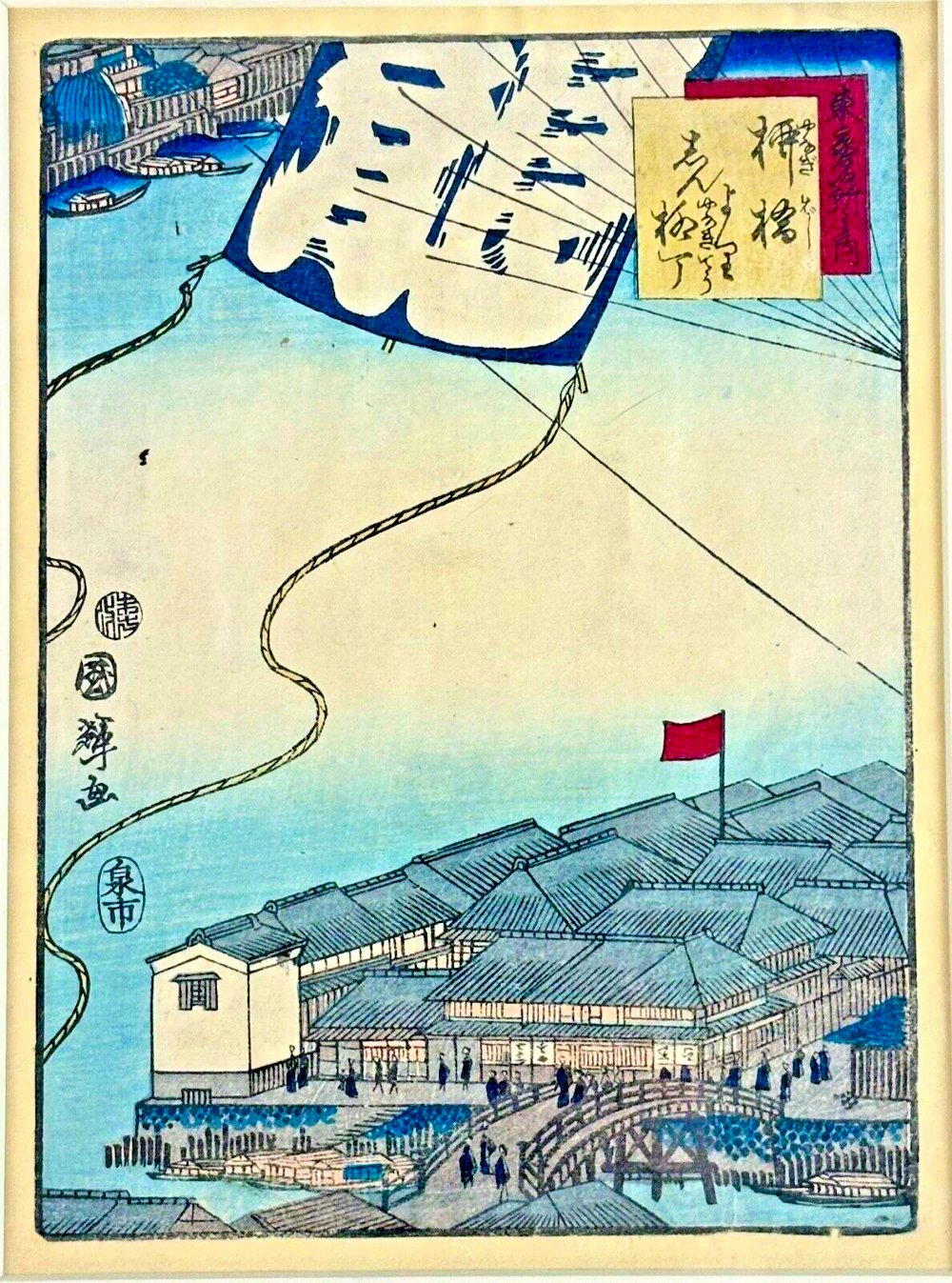| |
KUNITERU-II(Utagawa Kuniteru-II, Kunitsuna-II)
|

"From Yanagibashi to Shin
Yanagichō"
("Yanagibashi yori Shin Yanagichō", "柳 橋よりしん柳丁")
Series: Tokyo's famous places (東京名勝之内, Tōkyō meishō no uchi)
(1871)
("Yanagibashi yori Shin Yanagichō", "柳 橋よりしん柳丁")
Series: Tokyo's famous places (東京名勝之内, Tōkyō meishō no uchi)
(1871)
Comment
- A large Edo Kite with it's many
bridle lines and the two long rope tails is majestically
dominating the sky. The white Kanji on the blue kite
stands for "Dragon" (ryo, 龍), often to
be seen on classical "Kanji
kites" ("ji tako", "字凧"). The large river dominating
the scene is the Sumida River (Sumida-gawa, 隅田川).
It's tributary is the
former Edogawa (江戸川), today known as Kanda River (Kandagawa,
神田川). The outer moat of the
Imperial Palace and the Nihonbashi River are all
distributaries of the
Edogawa. The Yanagibashi
Bridge (lower part of the print) crosses both sides of
the Edogawa, showing the densely populated areas.
A little bit upstream of the confluence of the Sumidagawa and Edogawa is the large Ryōgoku Bridge (両国橋, Ryōgoku-bashi), built in 1659 spanning the Sumida, often depicted by Hiroshige. The name of the bridge, meaning "two provinces", came from its joining Edo (the forerunner of Tokyo in Musashi Province) and Shimōsa Province. Thus the interpretation of the white Kanji, only partly to be seen on the Edo kite, may also be interpreted as Ryōgoku (両国).
The series title is written in the red cassette (upper right), the yellow cassette contains the title of the print, describing the passageway over the bridge.
Series - Tokyo's famous places (東京名勝之内, Tōkyō meishō no uchi), showing a series of prints of famous places ("prides") in and around Tokyo.
Artist - see Biography
Signature - Kuniteru ga (国輝画) center left with a combined date-aratame censor seal (Meiji 4, according to I-1871)
Publisher - Izumiya Ichibei (和泉屋市兵衛) with Sen’ichi publisher's seal (泉市)
Image Size - 21.6 cm X 16.5cm (8 15/32" x 6 1/2")
Condition - single sheet; nishiki-e (cloured woodblock); small vertical ôban (ôban tate-e);
A little bit upstream of the confluence of the Sumidagawa and Edogawa is the large Ryōgoku Bridge (両国橋, Ryōgoku-bashi), built in 1659 spanning the Sumida, often depicted by Hiroshige. The name of the bridge, meaning "two provinces", came from its joining Edo (the forerunner of Tokyo in Musashi Province) and Shimōsa Province. Thus the interpretation of the white Kanji, only partly to be seen on the Edo kite, may also be interpreted as Ryōgoku (両国).
The series title is written in the red cassette (upper right), the yellow cassette contains the title of the print, describing the passageway over the bridge.
Series - Tokyo's famous places (東京名勝之内, Tōkyō meishō no uchi), showing a series of prints of famous places ("prides") in and around Tokyo.
Artist - see Biography
Signature - Kuniteru ga (国輝画) center left with a combined date-aratame censor seal (Meiji 4, according to I-1871)
Publisher - Izumiya Ichibei (和泉屋市兵衛) with Sen’ichi publisher's seal (泉市)
Image Size - 21.6 cm X 16.5cm (8 15/32" x 6 1/2")
Condition - single sheet; nishiki-e (cloured woodblock); small vertical ôban (ôban tate-e);
Copyright 2008 ff: Hans P. Boehme